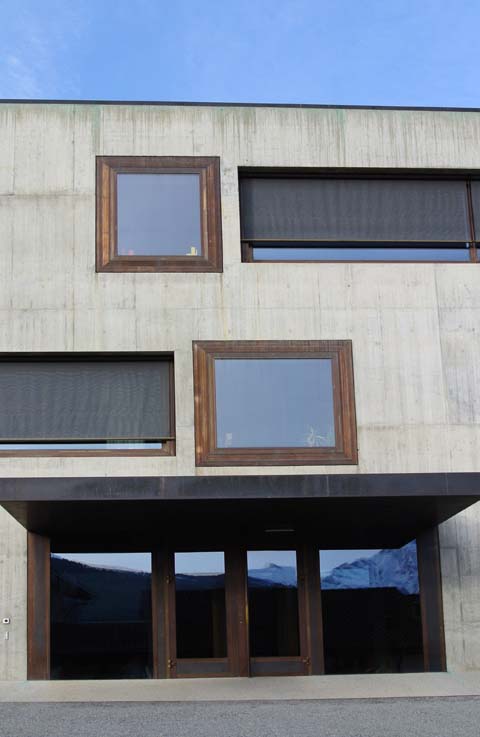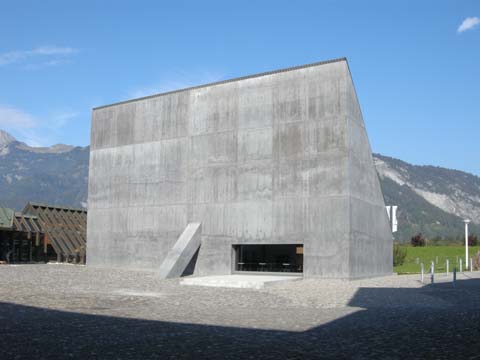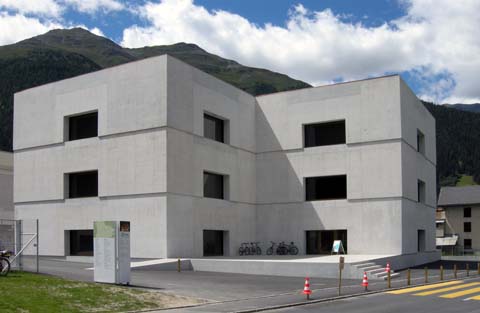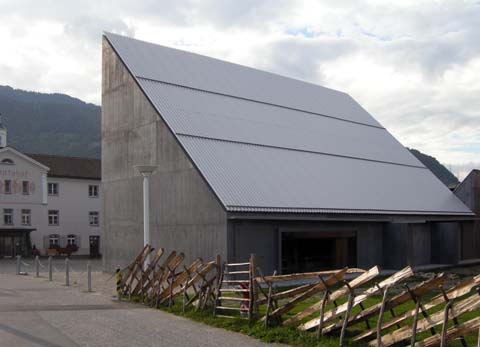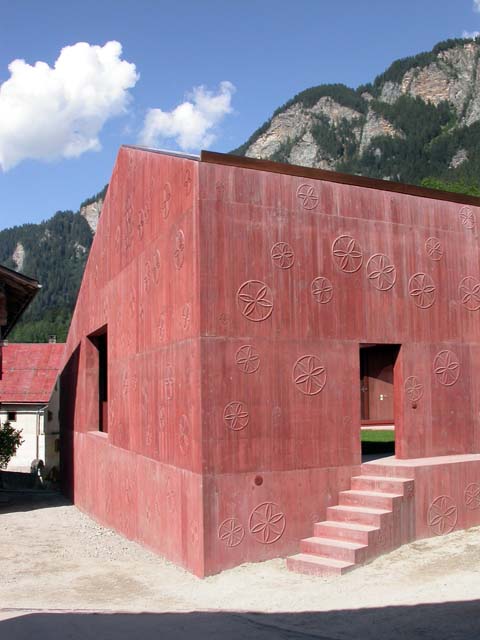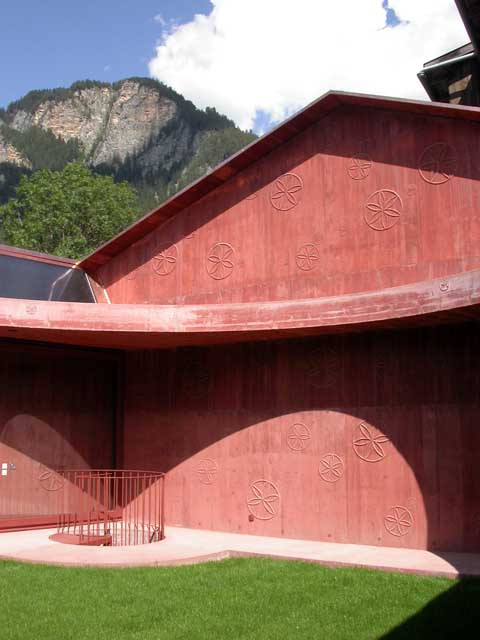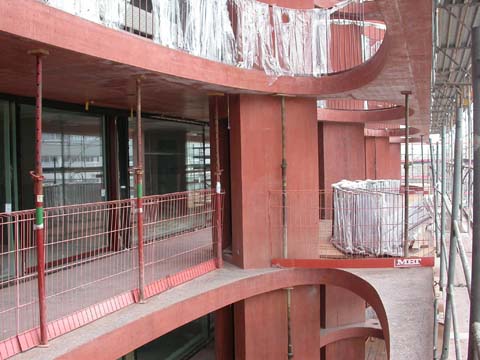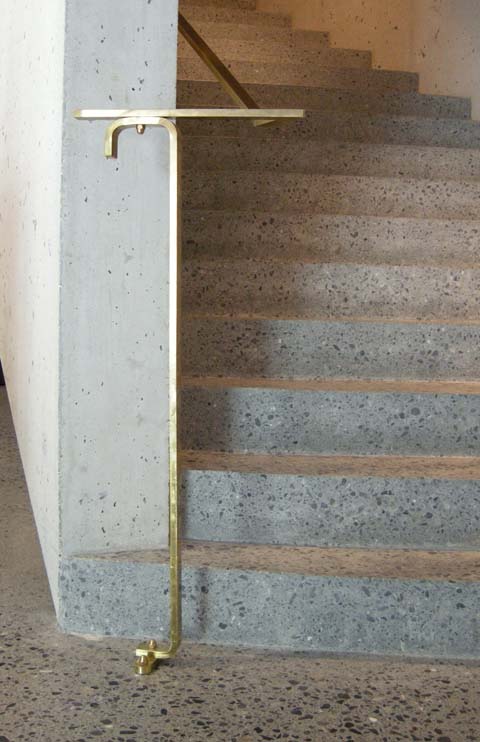| publications |
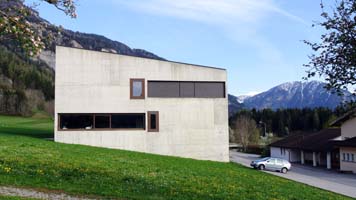 |
Secondary School, Paspels, 1998, Valerio Olgiati, (photograph: Daniel A. Walser) |
| • publications | • articles on architecture | • articles on art | • projects |
| Daniel A.Walser | • contact | • identity |
|
Valerio Olgiati: Works Valerio Olgiati, in: World Architecture, Daniel Walser, issue editor, Beijing, No 8 / August 2012.
Idea expressed by structural invention The Swiss architect Valerio Olgiati develops ideas in his architecture studio in the village of Flims in the middle of the Alps. The location might seem cut off from where you would normally expect such an international operating architecture office. But Flims is not rural and is very much a local skiing centre for the urban winter tourism. Living and working apart from the fast changing architecture fashions a quality in Olgiati's constructions. It allows him to concentrate in an independent way and develop unique architecture. Unique in the sense that Olgiati emphasizes structural and spatial essence. The result of Olgiati's design process is often astonishing for the viewer. The radical physicality that his buildings depict is different to what we are used to seeing in contemporary architecture. I remember, when I visited his Secondary School in Paspels (1998) a short time after completion, I was amazed by the radical yet very natural attitude of the building in situ and the inner spatial yet unexpected complexity. In the meantime this school building has aged in its material texture and formal expression exceedingly well. It is a timeless architecture. The building convinces the viewer with its almost self-evident presence. The secondary school building stands on the other side of the street to the existing primary school, in a field. The outer almost monolithic volume shelters the surprising inner spatial by its nutshell concrete form. By stretching the layout on two diagonal ends Olgiati shifted the parallel axis to a slightly different perspective. From outside the building still looks rectangular but inside one experiences the rooms as dynamic. One never expects such a compelling space inside a reduced volume. Outside light from the field reflects into the cross-form corridors, thus bringing seasonal colours into the concrete volume. The classrooms themselves are covered in wood to reflect something traditional and warm and so gives the pupils a personal place. The inside is a rich play of light, colour, space, and materiality.
The design idea as a backbone For Olgiati the building idea needs to be much more than a mere functional organisational scheme. It is not about the construction or site-specific interpretation of a genius locus, as in the School in Paspels he designed an independent volume. The idea aims to be more universal and therefore more abstract. Architects today need to work as close as possible with all kinds of specialists to fulfil today's necessities. Olgiati goes the other way around. He does not believe in the specialisation in our society. The building has to last longer than specific technical solutions. With his design idea Olgiati aims to solve more than one aspect of the project. Otherwise specialists will take over the project and such particular specific interests will change the design direction, and in architecture this may not necessarily be in relevant directions. For Valerio Olgiati it is important that the architect remains in charge of the design process, as the architect in the past always was when building structures out of ideas. In the long run such resulting architecture will be more sustainable.
Spatial framing of the idea through structure Further emphasis on structure can be observed in the project for the Learning Centre for the EPFL in Lausanne (2004). The invented space is spatially an even more explicit skeletonal organism. Even, if the building somehow retains massive parts, set in relation to its dimensions and the placement of openings, the building has been designed to its structural limits. If one would remove one element of the structure the building would collapse. This building system has also been applied in commercial jobs as the Binz office building in Zurich (2001) or the modular tower as in Lima (2010-). The process of designing properties of structure and the use of concrete in Olgiati's architecture is in reference to modernist architecture after the Second World War. The structural framing of space leads to an architecture formulated by the late Le Corbusier as we can find in the Monastery of La Tourette (1956-1960) or in his government buildings in Chandigarh (1952-1959). Such a radical conceptual design approach and structural framing of space can be understood as a connection between the architecture of the late Le Corbusier and Olgiati. Especially in earlier work as the school building in Paspels, Olgiati likes to work with the geometry and define space in such a radical way, that he is very close to the architecture of Louis Kahn and other exponents of Brutalism architecture. Especially Kahn was able to create structural solutions with an overall idea binding the volumes together as in the Salt Lake Institute (1959-1965). The fundamental difference between Olgiatis work and modernist buildings lies in his use of advanced building structure techniques to reduce the materiality of the structure not in an additional way but as a sculptural organism.
Dual dynamics of space One perceives Olgiati's Visitor Centre for the Swiss National Park in Zernez (2002-2008) as a simple and clear-cut building, two connecting cubic volumes with windows. But when one arrives at the staircase one is not sure which way to go, and if only one is the right way. This irritation helps to make the building richer in experience. This building is not just a sequence of rooms. Every visitor has to search his own way through the building and creates his own museum in his mind. When one visits the Plantahof Auditorium in Landquart (2008-2010, one does not immediately understand the use of the beam sticking out of the building volume on the outside. When one steps inside it is not clear either what exactly is happening. It starts to be more interesting when one connects the two images in mind and thinks about what one sees. Then one might realise that the inner concrete structure is a hybrid one partly hanging from the ceiling, partly a massive one standing on the ground. This tension between the outside and the inside gives the architecture a spatial richness.
In dialogue with historical architecture knowledge
But it is not just traditional or vernacular buildings, which form a basis for Olgiatis architecture. The impressive urban presence of Palazzo Strozzi in Florence by Giuliano da Sangallo (1489-1539) is very much based on the development of its facade. In several of Olgiati's buildings, as the School in Paspels and even the Museum in Perm (2008) the physical facade presence of dominates building volume. This research leads to the question of unity in architecture. In Olgiati's collection of the iconographic autobiography one finds a plan of the Villa Rotonda by Andrea Palladio (1567-1591) as well. This villa is not just a house on a hilltop, it represents an idea of lifestyle with surroundings, and life. It is almost an icon for an architecture where an entire life is reflected. In Valerio Olgiati's architecture such inseparable unity is aimed for.
Expression and meaning The building consists of a ramp a supporting half-shield like element, a pillar, and a roof, which is not connected with the building in the arsenal. This radical reduction of elements for the given task surprise in its simplicity and in the monumentality of the given solution. The surreal aftermath of placing the cantonal parliament in an unused arsenal with access to it from the side is finally given a representative architectural solution by Oligati. It is a new architecture, invented to solve a specific problem with an appropriate non-standard solution. The use of non-conventional forms, images, and types can provoke people too, because one has to think about the given solution.
Structure as a reflection of today Valerio Olgiati is not the only architect working with such issues. The abstraction in the Architecture of Kazuyo Sejima and Ryue Nishizawa from Sanaa, the material presence of David Chipperfield or the essential structural research of Christian Keresz show how Valerio Olgiati is part of a larger movement in architecture for a fundamental research in possible development of architecture. The outstanding achievement of Olgiati's contribution lies in the ambiguous complexity he achieves. His architecture is multi-layered in its interpretation of architectural expression, and yet a clear idea, which restrains the complexity and keeps his architecture Straight and pragmatic.
Text by Daniel A. Walser World Architecture, Beijing: Editorial presentation |
|
Copyright © 2005-2015, Daniel A. Walser, Zurich, Switzerland. All rights reserved. |
